Kyra Kristmanson
October 18th, 2019
EDCI 352
Observations (October 3rd, 2019)
Students in the classroom shared their anxieties, largely surrounding school work, finances, and graduation. We, the mentor teachers, shared our anxieties as well, creating a bridge of empathy, understanding, and community within the classroom. This was beneficial to our future project, as it broke the ice between us—a group of strangers—and their already established classroom dynamic. This facilitated a bond of trust going forward, despite the lack of clear-cut instructions and framework for the projects.
The students were very knowledgeable about their school, and the mentors got a comprehensive tour of Esquimalt High.
Observations (October 7th, 2019)
The project groups and ideas have started to come together. We initially separated the students and mentors by more “creative” and “non-creative” projects—facts and science based versus arts based would have been a more accurate description, as projects with a scientific basis can be equally creative. Once narrowed down to a majority arts-based group (the science-based groups left to start their individual projects) we had to separate categories further. Out of the three categories, I signed up to lead a performing arts group, though I also let the students interested know that I have a lot of experience with writing as well. Together we decided to do an interpretive dance to spoken word and poetry. The theme we chose is anxiety around climate change, with a call-to-action at the end.
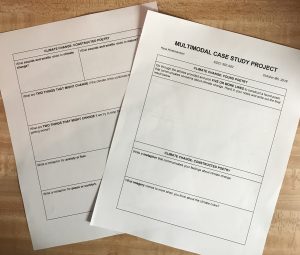
Handouts Created for Found Poetry
For next time, I needed a few handouts to ensure the students are generating ideas in a forward trajectory due to the time constraint around the project. I hoped to accomplish at least a general structure for the dance from start to finish. As for the writing, we needed solid points to connect between the poetry and dance, so I would need to prepare handouts to facilitate that.
I learned that the students are great natural collaborators, but they need help setting realistic parameters around projects. Focusing in on one idea they can all contribute to is important.
Observations (October 10th, 2019)
Together, the group established the framework for the poetic narrative and story structure for the dance. In storyboard style snapshots, we broke the dance up into five acts by using the handouts I had prepared.
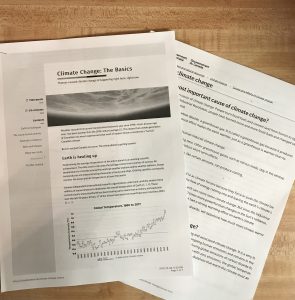
Handouts Created for Found Poetry
Some students are more resistant to cooperation and keeping expectations realistic. Today I learned that I will need to find a way to engage one particular student if the task they are determined to stick to does not work out. For next week I needed to take a hands off approach, letting the student learn through trial and error, and be ready to give her a new task if the one they try does not work out.
I also learned that delegating tasks to the students takes stress off of yourself as the mentor. It also gives students ownership and agency over their project. Once the framework and criteria is established, students are capable of taking the reigns. I also learned that backup plans are a great idea, but they don’t always end up being necessary. Students did not require prompts from found poetry, and were excited to produce their own original poems.
Observations (October 17th, 2019)
The students began working on their choreography, and came prepared with poetry. The three dancers followed the structure they had prepared during our last meeting, and began working immediately. One student tried to get the tech booth up and running but had difficulties. They asked for help from a fellow student, unfortunately neither were able to figure it out. A little dejected, the student came to ask me what they could do instead.
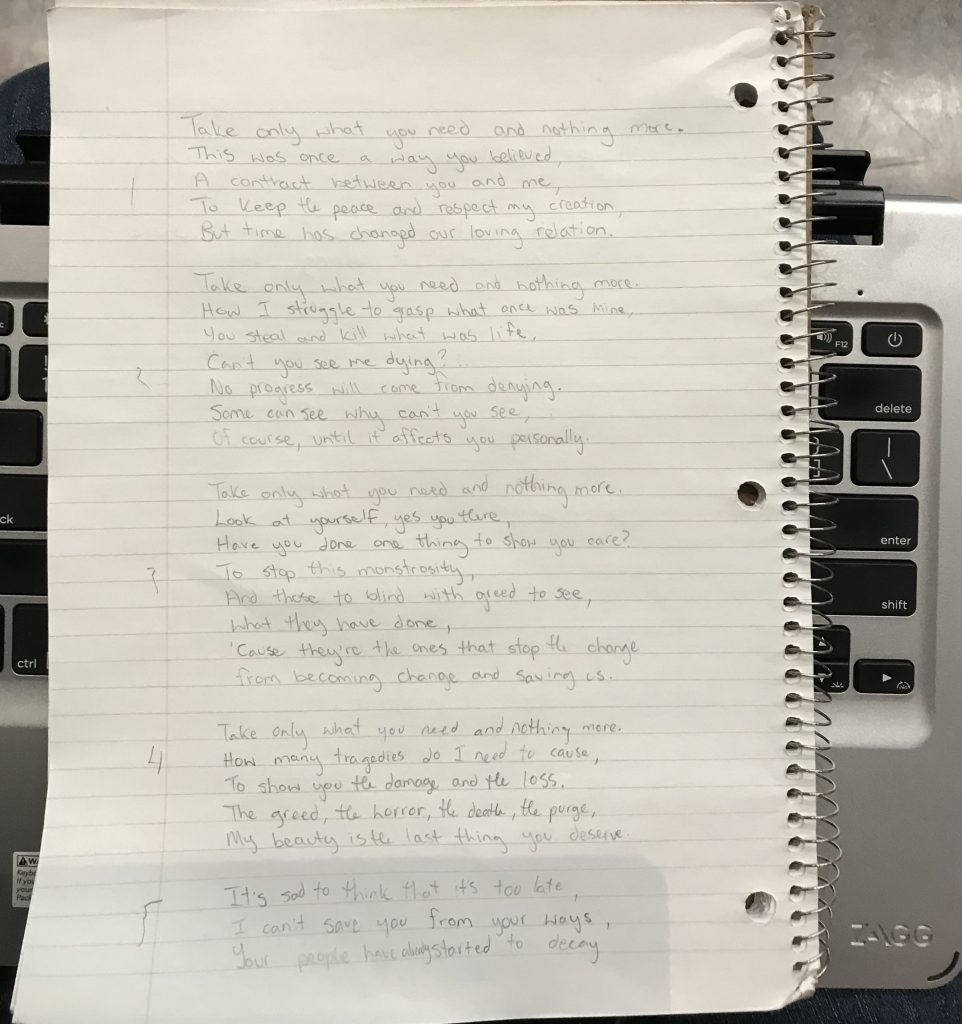
One Student’s Poem for the Project
Thankfully, I had planned a backup as I had predicted we might run into technical issues. Together we went up to the library to work on the soundtrack for the dance. By the end of the block, they seemed confident in working with Audacity, and even found a teacher to help them with the tech booth issues for next week.
Unfortunately, I did not have much time to check in with the progress of the choreography. The students said it went well, and that they had a good idea of how their dance would begin and end. Next week, we would need to make some decisions around how the project will be prepared and presented within our time constraints.
Observations (October 24th, 2019)
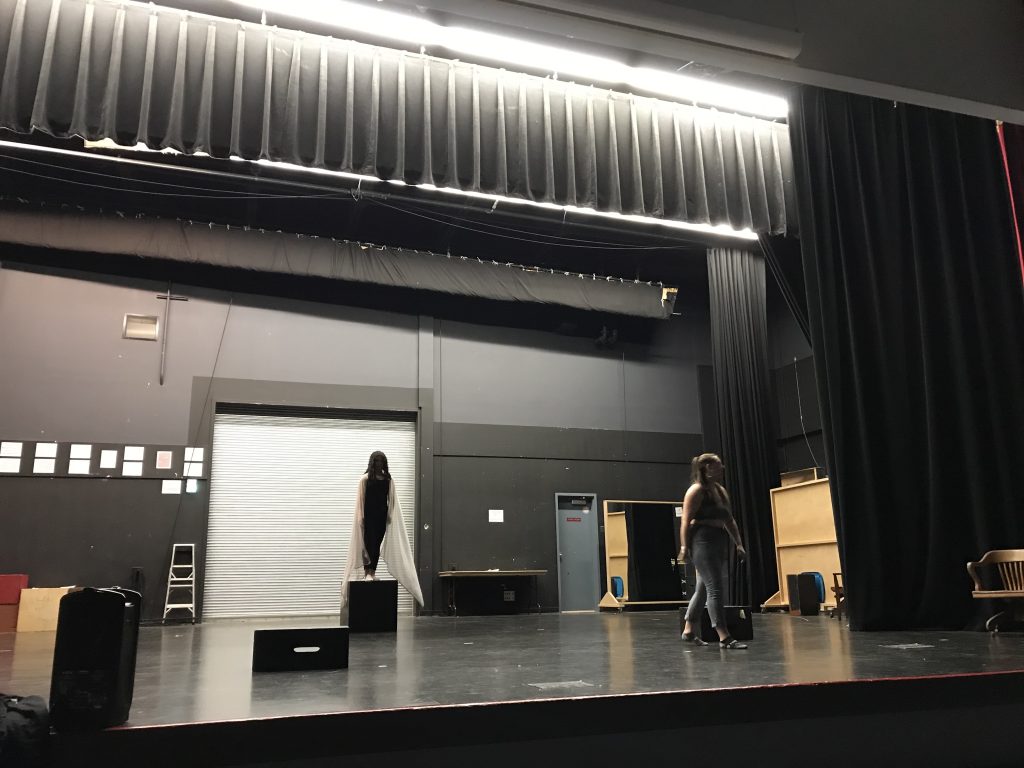
Students rehearsing their dance
On the Monday prior I was sick and had to stay home. While I was away, the students continued to work on their choreography and strategized how they would combine the two original works of poetry contributed so they would work with the story of the dance. Despite all of their hard work, there wasn’t enough time to make the original plan for the performance fit within our time constraints. Without time to record film and finish audio, we had to come to a compromise. When I came back on the Thursday, the students and I went to listen to a creepy soundscape designed by another group, and decided to use this in the theatre during the dance—giving the other group a place for their own work to be showcased at the same time.
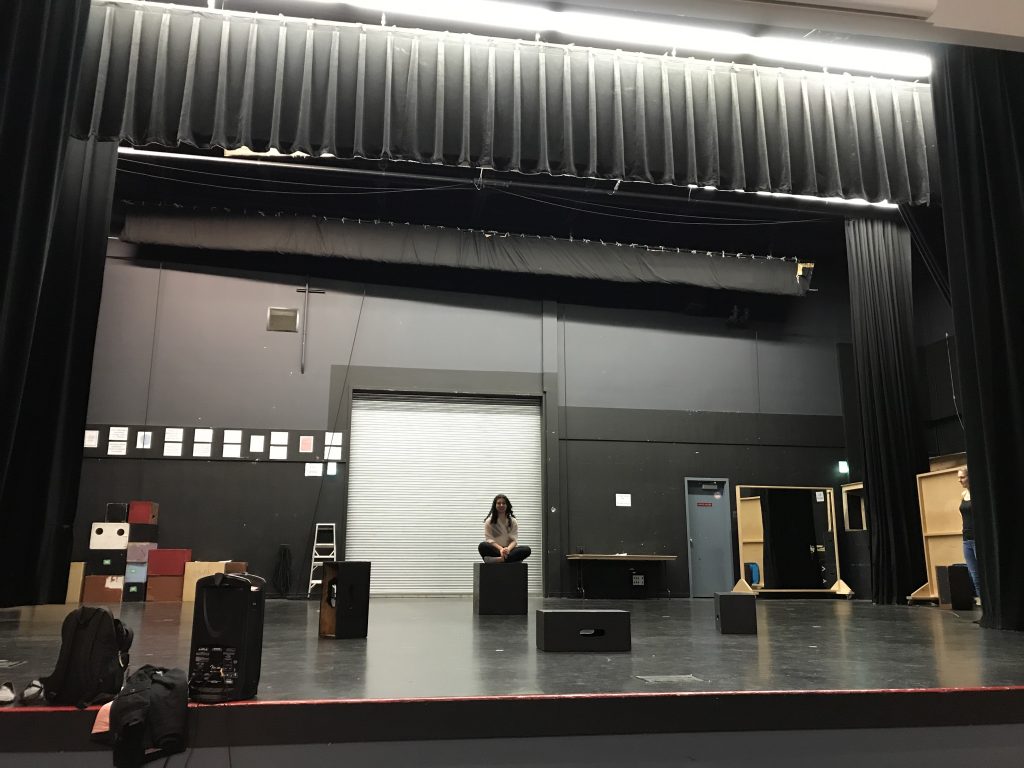
Students rehearsing their dance
The students were very flexible with the changes to their presentation, and I thanked them for their patience and understanding. They worked with the challenges that came up, and they were highly adaptable in the face of those obstacles. I did encourage them to continue to work on their project after the presentation date—if they still wanted to realize the original outcome they had hoped for. I reminded them that there will always be more opportunities, even if this one passes by.
Observations (October 28th, 2019)
We did it! The dance went over with a few technical hiccups—and in the cafeteria instead of the theatre—but overall it was brilliant! I learned a lot about working with students, and project-based learning. The students were proud of their final product, even though it didn’t turn out exactly how they had originally planned, but they totally rolled with the punches the entire time. I was very fortunate to have such a laid back but passionate group of kids to work with at Esquimalt High.
The students were able to perform their dance several times in the block of presentation time we had to work with, and they had quite a few people come to see the final product. The soundscape went over beautifully, and the spoken word poetry worked well with the rest of the performance. The students were able to speak to their roles in the project with confidence, and expressed their reasoning for choices made throughout the project. They should be very proud of their accomplishment.
Overall Observations and Connections to Course Material:
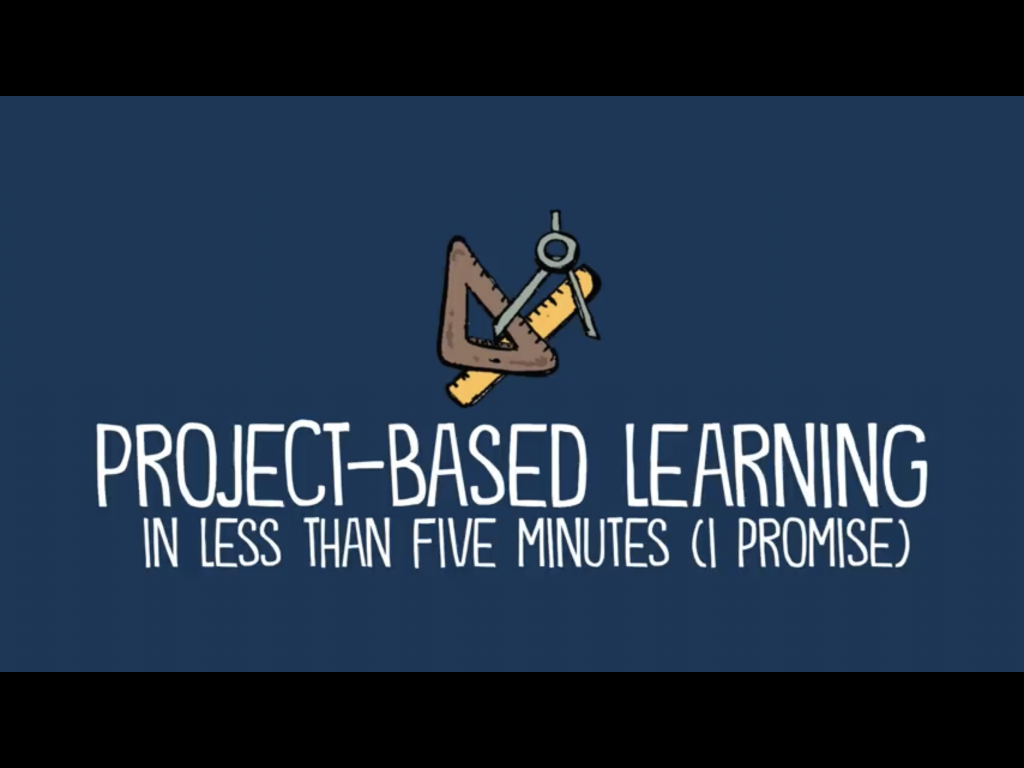
A Snapshot of John Spencer’s Video
In my Socials Methodologies course (EDCI 773) we discussed Project-Based Learning, which connected to this experience perfectly. We discussed a video entitled “What Is Project Based Learning?” created by John Spencer. Spencer discusses his own experience in high school as an introvert with only a single friend, and how his teachers encouraged him to begin an inquiry project that combined his passions for baseball, history, and social justice. By allowing him to explore these interests across multiple mediums in order to compile his findings, and he went on to compete in a National Competition held in Washington, DC.
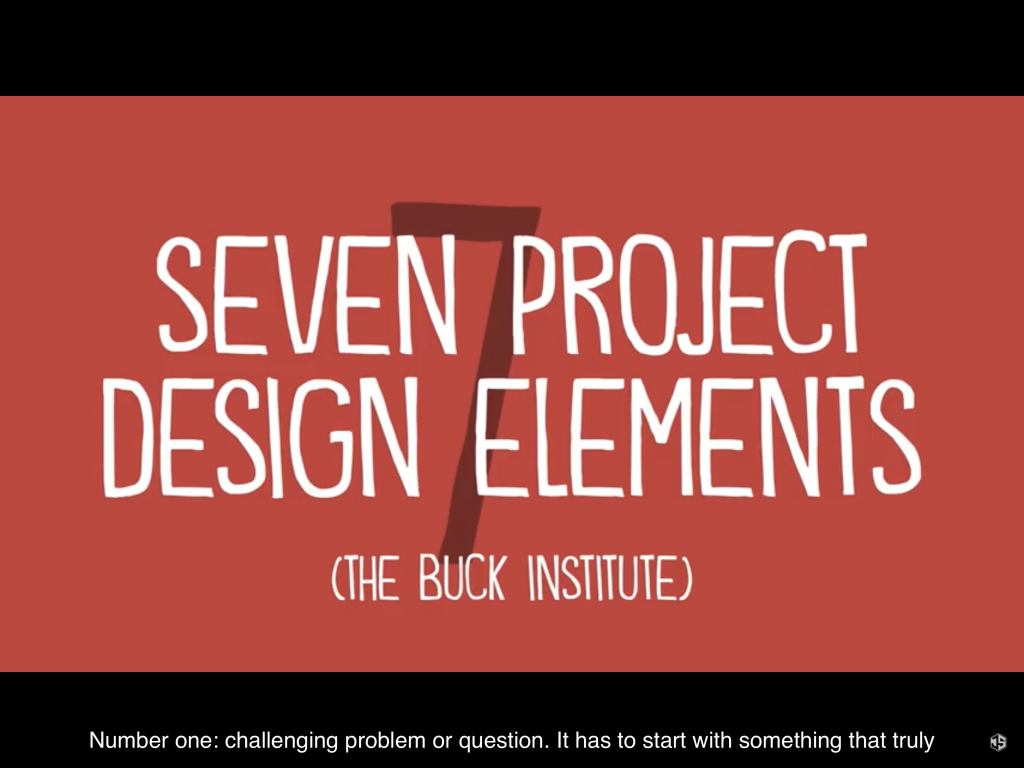
A Snapshot of John Spencer’s Video
Spencer’s video breaks down the difference between traditional and inquiry based projects. He highlights the difference made by allowing for student choice in design rather than relying on teacher choice in design. During my time at Esquimalt High, I was able to observe this in action. By allowing students to make the major decisions around their project, they are fully invested, engaged, and learning without even realizing it. They are exhibiting skills like respectful listening, collaboration, and cooperation—all of which create a sense of community and teamwork among the students. This could even be a partial answer to my own inquiry question: how do we create a culture of empathy in the classroom?
You can watch John Spencer’s video here.
Greta Thunberg’s speech at the United Nations was a big influencer of this project. I listened to the speech with one of the students who hadn’t heard it yet, and right away they were interested in incorporating aspects of her message. With the climate strike happening shortly before the beginning of this project, the students were excited to develop a similar political message—a call-to-action for their viewers. Originally, we had planned to pull soundbites from her speech to spread throughout the recording of poetry the dance was going to be set to. Together, we grabbed phrases like “the science has been crystal clear,” “we will never forgive you,” and of course the infamous: “how dare you.” Even though the sound clips did not make their way into the final project, I believe the students’ own message is as powerful as Greta’s, and they should be very proud of their work.
Final Thoughts and Considerations:
I will say that I’ve made a few discoveries about my own teaching philosophy and style throughout this case study. Although the project went very well, I do think that more structure to begin with would have minimized the stress levels of the students and myself. I also think the time constraint was too condensed for such a massive project—this would be something I would probably spread across a semester. I also would have organized presentations much farther in advance, making sure that students knew exactly where their work would be displayed long before the due date. An actual gallery walk presentation throughout the entire day—or one block per day for a week—would have given greater opportunity for the projects to be shared widely, and performances could have been held in the theatre at specific times. In general, I would have organized a lot more.
